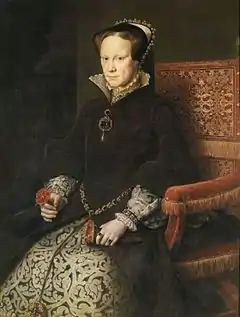List of artworks with contested provenance
Throughout the world, there are many works of art that have a contested provenance. This may be due to theft, lost documentation, looting, or just information lost to antiquity. In some cases, just the previous or current ownership of the work is disputed, but in other cases the authenticity of the work itself may be thought to be a forgery.[1][2] During World War II, Nazis stole many works of art from Jewish families, or looted them from cities in the war.[3][4][5]
Cleveland Museum of Art – Apollo Sauroktonos by Praxiteles
The Cleveland Museum of Art purchased a bronze sculpture of Apollo Sauroktonos, which some believe to be the only bronze in existence from the original Greek artist Praxiteles. However, the work has an incomplete provenance, and some claim it is a later Roman copy.[6][7]
Louvre – Bronze Monkeys
Recently there has been debate within the antiques industry regarding a bronze monkey held in the Louvre initially believed to be the work of famous sculptor Giambologna. Following the finding of two other bronze monkeys by British antique dealer Colin Wilson, however, the validity of the monkey held in the Louvre, claimed by 'experts' to be the real work of Giambologna, has been called into question. The Louvre monkey is simply too deep to fit the niche in which it was supposedly situated on the Samson and a Philistine fountain it was originally designed and created for. The quality of the monkey in the Louvre is also up for debate; the form is not lifelike, the fur is not realistic, and the pose does not match the poses of the monkeys in the Uffizi drawing, which is the only evidence for the monkeys being in the niches. Colin Wilson's monkeys, however, do match this drawing, are made of a gunmetal dated to the 16th/17th century, are unrefined, and are of a high lead content, all of which are traits of a work of Giambologna. The debate continues to this day. In July 2008, the Colin Wilson monkeys, along with a newly discovered third, were sold at auction.[8]
Republic of Austria – the equestrian painting of Bellini from the Sarah Lederer Collection
Ernst Lederer, a well known art historian, has been "dazu bewogen" (induced) to "donate" this valuable painting to the Republic of Austria in return for an export license for a fragment of the large Lederer[9] collection which was destroyed at the end of the war by SS troops at Schloss Immendorf (including famous paintings by Klimt and Schiele) or like the textiles and drawings disappeared during 1938–1940.[10] In such a case Austrian courts would refuse to accept any claims for compensation. The famous Klimt Fries in the Lederer collection was, however, not included in the export license, and it took until the 1970s when Chancellor Bruno Kreisky himself started negotiations for the Republic of Austria to buy the Klimt Fries from Lederer.When Erich Lederer had tried to get back the Bellini painting in the 1950s the Austrian Ministry for Education refused.[10]
Other items

- Victorious Youth
- Getty kouros
- The "Mary Tudor" pearl, one of the most famous stones in the crown jewelry of Spain, most commonly associated with the pearl known today as La Peregrina, but the Pearl of Kuwait is also claimed to be historical original.
- NSW Art Gallery Indian Statues[11][12][13]
- Tilla Durieux portrait by Oskar Kokoschka[14]
See also
References
- Laney Salisbury; Aly Sujo (2009). Provenance: How a Con Man and a Forger Rewrote the History of Modern Art. Penguin Publishing Group. ISBN 978-1-101-10500-9.
- Rodolfo Peña (2012). The Minister's Secret: A Guillermo Lombardo Mystery in Paris. Untreed Reads. p. 64. ISBN 978-1-61187-450-1.
- "Swiss Website Aims to Help Museums Track Nazi-Looted Art". Bloomberg.com. 17 June 2013. Retrieved 29 November 2020.
- "BAK – Bundesamt für Kultur – Raubkunst".
- "Hezbollah meets the IRA at the European Union - Opinion - Jerusalem Post". www.jpost.com.
- "Cleveland Museum of Art's Apollo sculpture is a star with intriguing past". Retrieved 25 October 2011.
- Stodghill, Ron (18 March 2007). "Do You Know Where That Art Has Been?" – via NYTimes.com.
- "Now a third Giambologna monkey emerges". www.antiquestradegazette.com.
- "Stealing beauty - Haaretz". 3 January 2017. Archived from the original on 3 January 2017.
- (PDF). 3 January 2017 https://web.archive.org/web/20170103065254/http://www.demokratiezentrum.org/fileadmin/media/pdf/rathkolb_artloot.pdf. Archived from the original (PDF) on 3 January 2017. Missing or empty
|title=(help) - "Subscribe to The Australian | Newspaper home delivery, website, iPad, iPhone & Android apps". www.theaustralian.com.au.
- "Subscribe to The Australian | Newspaper home delivery, website, iPad, iPhone & Android apps". www.theaustralian.com.au.
- Srivathsan, A. (28 June 2013). "New images of stolen Nataraja surface" – via www.thehindu.com.
- "Nazi looted art cases remain unsolved mysteries | DW | 20.06.2013". DW.COM.